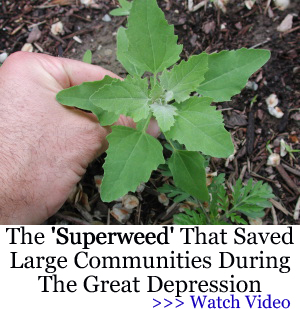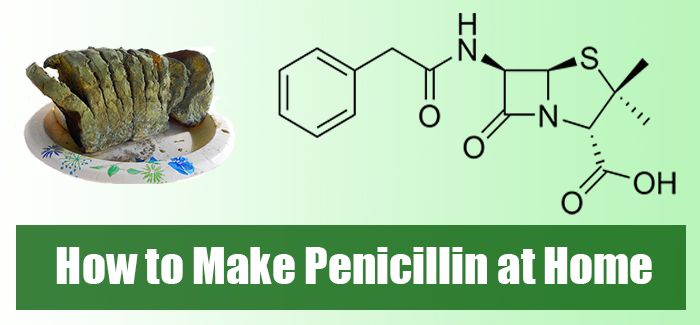One of the risks most of us will face after the collapse will be an almost total lack of medications. Many of us will sicken and die over things that were not considered serious before SHTF. After having read this article you learn how to make Penicillin at home. You can either start to make you own penicillin or just use the information in case SHTF or TEOTWAWKI.
Just to give you an idea about how precious it will be to know how to make Penicillin, think of this: during the early penicillin era, the drug was so scarce and so highly valued that doctors did something unthinkable. They collected the urine from treated patients. Then, they isolated the penicillin in the urine to use on other patients.
About Penicillin
Penicillin is an antibiotic that fights bacteria, fungi or microbes in our body. Penicillin was the first discovered antibiotic (1933). The term means against (anti) life (bio).
Penicillin: C16H18N2O5S
The discovery of penicillin and its medicinal uses was arguably the most important medical discovery of the 20th century. The production of penicillin is a process that has changed dramatically since its beginnings.
Opposed to what most people think, doctors do not use penicillin only for treating colds. The antibiotic also treats serious diseases like Typhoid Fever, Syphilis, Pneumonia, Meningitis, Anthrax, Tetanus Tuberculosis, Chlamydia, Abscesses, Leptospirosis, and Lyme disease.
But the most important thing is that it treats infections. Simple cuts can begin to show infection very fast when SHTF. And without an antibiotic, you can develop septicemia (blood infection) or gangrene which are deadly without very powerful antibiotics or surgery. Without antibiotics many people had died because of simple wounds including kings such as Louis XIV, Napoleon III or Gustav III of Sweden.
How to Make Penicillin at Home?
1. Make Penicillin Fungus
In order to make penicillin at home you first need to grow the Penicillin fungus. The most important thing to remember is to always use sterile techniques or you will likely wind up with growing something else!
Expose a slice of bread to the air, in a dark place and normal-high humidity, at 70 deg. F until a bluish-green mold develops. This process may last up to 7-14 days.
The mold will start out gray, but as it develops will turn bright blue-green. After the mold starts appearing, cut the bread up into pieces and put it in a sterilized flask. Incubate it in the flask for about a week in the same conditions.
You can also make the penicillin the same way out of the peel of citrus fruits, cantaloupe or salami. In fact, Pfizer grew the fungus through citric acid and fermentation.
2. Prepare the Solution to Separate the Penicillin Substance from the Fungus
Dissolve the following ingredients, in the order listed, into 500ml of cold tap water:
- Lactose Monohydrate – 44.0 grams
- Cornstarch – 25.0 grams
- Sodium Nitrate – 3.0 grams
- Magnesium Sulfate – 0.25 grams
- Potassium Phosphate Mono – 0.50 grams
- Glucose Monohydrate – 2.75 grams
- Zinc Sulfate – 0.044 grams
- Manganese Sulfate – 0.044 grams
Then add enough cold tap water to make one liter. Use Hydrochloric Acid to adjust the pH between 5.0 and 5.5.
3. Separate the Penicillin substance
Pour the solution into sterilized milk bottles. Use only a small quantity. When you place the bottle on its side, the media should not reach the plug. Add approximately one tablespoon of the spores you’ve grown.
Incubate the bottles at 70 degrees Fahrenheit for 7 days. If the culture produced penicillin, you may see it now in the liquid portion of the solution following this incubation period. Filter the media (using a coffee filter or a thick canvas), plug the bottles and refrigerate immediately.
After a few hours use again the hydrochloric acid to adjust the solution to 2.2 Ph. Mix it with cold Ethyl Acetate in a Separatory Funnel and shake well.
Drain the ethyl acetate, from the bottom, into a beaker that was placed in an ice bath. Then, repeat the process. Add 1% potassium acetate and mix. Now wait until the ethyl acetate will evaporate off. This may take a while.
When it finally dries, the remaining powder contains Penicillin.
There are other ways to make penicillin. In fact, nowadays, pharmaceutical companies make penicillin using other, more complicated, methods. But this was the best solution when it first started. Watch this short video:
How to Test Homemade Penicillin Before Using It
Although you did probably make penicillium mold growing on the bread, it is possible you also got other molds. Even with the right kind of fungi growing, filtering out everything but the penicillin is difficult.
In order to be sure that you did make penicillin and not a toxic substance you have to test it!
You can measure antibiotic activity in a crude way by making a mold of agar in a petri dish with tiny depressions, introducing a drop of penicillin broth into each depression, inoculating the plate with a known, penicillin-susceptible bacteria, and observing the area of inhibition from the penicillin-laced depressions over several days, compared to controls into which only water has been introduced before inoculation.
If the result is positive, I suggest, before taking it, to try it on an animal in small quantities just to be perfectly sure it’s not harmful. In case you have a sick animal try it on it and see the results. It might get better very shortly!
The penicillin made from this experiment should not be used unless it is a survival situation.
You may also like:
 5 Food Storage Myths That Are Ruining Your Stockpile
5 Food Storage Myths That Are Ruining Your Stockpile
Similar to Morphine: The Best Natural Painkiller That Grows In Your Backyard (Video)
Best Backup Heaters You Can Buy For This Winter
Survival Hacks From The Civil War That Are More Useful Than Ever






















What is the shelf life for the ingredients listed above? Can they be stored long term?
Hi Kevin,
Most of them don’t have a listed shelf life. Because they are chemical compounds, they may last indefinitely, or at least for some generations.
The only one that can go bad is the cornstarch, but only if you store it in high humidity.
More so, the resulted penicillin may last for generations. Shelf life for most medicines including antibiotics is based on maximizing the profit not that the pills will go bad.
Everything has a half-life. Temperature is also a determining factor when calculating “shelf-lives” of meds. Chemicals dont just exist in perpetuity. They degrade. All it takes is time.
Great. But I’m allergic to penicillin. What now?
Look into “mega-dose” IV vitamin c (sodium ascorbate). Solid alternative to antibiotics.
And by the way, let’s hope someone will remember how to make bread.
Blue bread mold is Aspergillus and does not contain pennecillin at all. Pennecillium mold is white. If this worked at all for you, then it would be because you had a lot of contamination of the stuff you actually needed.
Haha, here it says that the mold should be green. https://realfarmacy.com/homemade-penicillin/
There is so much nonsense being spread around the Internet about this. I teach chemical synthesis, and can assure you, that you are far more likely to poison yourself trying to synthesize penicillin than you are to make an appreciable amount of uncontaminated, useful drug.
For far less than the cost of buying all these chemicals, and with none of the risk of a botched synthesis, you can just buy a bottle of fish antibiotics online. With the exception of tetracycline, most antibiotics are potent long past their expiration date if kept in a cool, dry, oxygen-free environment.
This synthesis method is interesting from an academic standpoint, but practical preppers need practical solutions.
Well… according to Google: About 200 species of Penicillium have been described. They are commonly called the blue or green moulds because they produce enormous quantities of greenish, bluish or yellowish spores which give them their characteristic colours. Spores from this species of mold are found everywhere in the air and soil.
call me at 307-331-7162 getting piss off..where is my order.
There’s a factual error early on in this article: you can’t treat a cold (or any other virus infection) with antibiotics such as penicillin.
When the SHTF I’ll be heading to the nearest pharmacy with my Glock and a large Garbage back and haul all the essential meds I can get back to my bunker. No way am I going to try to make my own penicillin..
Can I substitute battery acid for hydrochloric acid? This recipe reminds me of homemade TNT haha!